PAVILION VI
PROBLEMS OF REPAIR
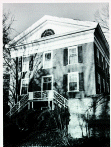 Pavilion VI has survived with much of its original building fabric intact, despite having undergone major renovations in the period 1860-75, in 1928-29, and in 1954. Although some original building elements were either removed or covered over at these times, most of the work that was undertaken involved either the building or remodeling of an addition to the east of the original building.
Pavilion VI has survived with much of its original building fabric intact, despite having undergone major renovations in the period 1860-75, in 1928-29, and in 1954. Although some original building elements were either removed or covered over at these times, most of the work that was undertaken involved either the building or remodeling of an addition to the east of the original building.
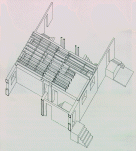 Pavilion VI, like most of the other original Jefferson structures at the university, is generally in good condition, although it has received uneven levels of maintenance over the past seventeen decades. This is the case largely because of the soundly designed original construction details, the use of high quality materials, and the care that went into the original construction of the building.
Pavilion VI, like most of the other original Jefferson structures at the university, is generally in good condition, although it has received uneven levels of maintenance over the past seventeen decades. This is the case largely because of the soundly designed original construction details, the use of high quality materials, and the care that went into the original construction of the building.
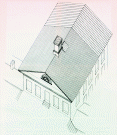 Pavilion VI exhibits relatively minor building problems, some of which are also found in the other original pavilions. These include differential settlement of the exterior walls and chimney masses; rising damp in exterior and interior masonry walls, exacerbated by the installation of modern concrete floors in the basement; roof problems caused by inadequate detailing, lack of flashings, or the deterioration and failure of surfaces; obsolete heating and electrical systems; lack of central air-conditioning systems; damage to original architectural features by the installation of modern heating systems; and damage to interior finishes caused by roof and/or plumbing leaks and uneven structural settlement. The following is an itemized listing of these problems in Pavilion VI.
Pavilion VI exhibits relatively minor building problems, some of which are also found in the other original pavilions. These include differential settlement of the exterior walls and chimney masses; rising damp in exterior and interior masonry walls, exacerbated by the installation of modern concrete floors in the basement; roof problems caused by inadequate detailing, lack of flashings, or the deterioration and failure of surfaces; obsolete heating and electrical systems; lack of central air-conditioning systems; damage to original architectural features by the installation of modern heating systems; and damage to interior finishes caused by roof and/or plumbing leaks and uneven structural settlement. The following is an itemized listing of these problems in Pavilion VI.
EXTERIOR
ROOF
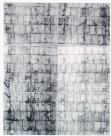
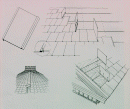 The existing standing-seam terneplate roofing was applied directly over the original tinplate roof installed at Thomas Jefferson's direction on the main block of the pavilion. From the evidence that still exists, the present terneplate was the only roof ever installed over the original tinplate. Although the metals are similar, the standing seam roof does not have the same appearance as the original Jefferson roof. The strong vertical lines created by the standing seams are very different from the even texture of the original tinplate shingles. Jefferson's tinplate shingles measured approximately 6-3/4 by 10 inches and were fastened together along the 10-inch vertical dimension using a single-lock seam without solder or lead paste. Two shingles were cut from a single 10 by 13-1/2 inch tinplate pan, which was the standard sheet size of tinplate available at the time Pavilion VI was constructed. The horizontal courses were lapped approximately two inches; no lock seams were used on the overlap. This particular use of tinplate pans was unique to Jefferson. The technology used to install the shingles is significant because it required only basic carpentry skills and not sophisticated tinsmithing techniques to work and solder sheet metal.
The existing standing-seam terneplate roofing was applied directly over the original tinplate roof installed at Thomas Jefferson's direction on the main block of the pavilion. From the evidence that still exists, the present terneplate was the only roof ever installed over the original tinplate. Although the metals are similar, the standing seam roof does not have the same appearance as the original Jefferson roof. The strong vertical lines created by the standing seams are very different from the even texture of the original tinplate shingles. Jefferson's tinplate shingles measured approximately 6-3/4 by 10 inches and were fastened together along the 10-inch vertical dimension using a single-lock seam without solder or lead paste. Two shingles were cut from a single 10 by 13-1/2 inch tinplate pan, which was the standard sheet size of tinplate available at the time Pavilion VI was constructed. The horizontal courses were lapped approximately two inches; no lock seams were used on the overlap. This particular use of tinplate pans was unique to Jefferson. The technology used to install the shingles is significant because it required only basic carpentry skills and not sophisticated tinsmithing techniques to work and solder sheet metal.
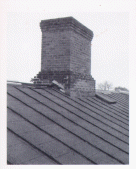 After a century of service, the standing seam terneplate roof is at the end of its life expectancy. The metal is badly rusted in place because of the lack of adequate maintenance, including painting. This lack of painting has caused the terneplate coating to fail, thereby exposing the underlying iron sheet. The resulting electrolytic reaction between the terne and iron caused the iron to corrode rapidly
After a century of service, the standing seam terneplate roof is at the end of its life expectancy. The metal is badly rusted in place because of the lack of adequate maintenance, including painting. This lack of painting has caused the terneplate coating to fail, thereby exposing the underlying iron sheet. The resulting electrolytic reaction between the terne and iron caused the iron to corrode rapidly
Chimneys and Access Hatch
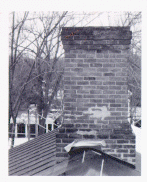
- The chimney flashings are deteriorated. The masonry where the flashing enters the chimney is heavily caulked, and some of the caulking has failed, permitting water to enter the joint.
- The chimney has been repointed in a sloppy manner with Portland cement mortar, which is not compatible with the original lime mortar. The cement mortar is harder and denser than the original and is less plastic. It is not self-annealing like the original lime mortar. Once a crack occurs in the cement mortar or between the mortar and a brick, it remains forever. Water is then free to penetrate the crack. With cyclical expansion and contraction, the crack widens, and eventually the masonry units are dislodged.
- The roof hatch is covered with terneplate, which, like the roof covering, is generally deteriorated because of the lack of maintenance over a long period.
Entablature
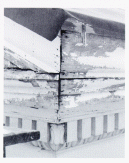 The entablature is generally in good condition. There is a heavy paint build-up on the wood; the paint coatings are alligatored and failing in other ways because of the excessive thickness of the paint. There is localized deterioration of the wood moldings caused by roof and gutter leaks. The horizontal moldings of the north and south elevations have been covered with sheet-metal flashings at some time within the past half-century. These flashings are deteriorated; the seams in the metal have failed, and the flashings have separated from the wood moldings.
The entablature is generally in good condition. There is a heavy paint build-up on the wood; the paint coatings are alligatored and failing in other ways because of the excessive thickness of the paint. There is localized deterioration of the wood moldings caused by roof and gutter leaks. The horizontal moldings of the north and south elevations have been covered with sheet-metal flashings at some time within the past half-century. These flashings are deteriorated; the seams in the metal have failed, and the flashings have separated from the wood moldings.
West Elevation
- There are open joints in the flush boarding of the pediment.
- There is heavy paint build-up on the pediment fanlight, and the glazing putty has failed. The wood trim and sill are deteriorated and are in need of consolidation.
- On all the woodwork and shutters there is a heavy build-up of paint that obscures molding profiles and detailing. In many areas the paint is alligatored, cracked, and peeling.
- The column shafts have a heavy build-up of paint and whitewash, which obscuresthe detailing.
- The capital of the south column has deteriorated from water leaking into it.
- There are no drip edges on the horizontal moldings of the entablature. Drip edges are necessary to shed water away from the surfaces of the moldings so that water isless likely to penetrate behind the wood elements and cause damage to unprotectedareas.
- The wood steps to the main doorway are worn, and the bottom of the north stringer
is broken.
Porch, West Elevation
- The second floor porch balustrade is in need of maintenance. Wood members are deteriorated and joints have come apart.
- The fascia trim and supporting beams are rotted at the south end.
- The beaded board ceiling of the porch has opened up in areas.
East Elevation
- There are open joints in the flush boarding of the pediment.
- The flashing on the horizontal element of the pediment is deteriorated and the joints have opened.
- On all woodwork there is a heavy build-up of paint that obscures the molding profiles and detailing. In many areas the paint is alligatored, cracked, and peeling.
Porch, East Elevation
- The character of the back porch is inappropriate for the building because it is an overly elaborate, pseudo-Federal period design that is not similar to any porches Thomas Jefferson designed at the university.
- There is substantial deterioration of the wood stairs and baluster; many of the joints have opened. Much of the paint is loose and flaking.
North and South Elevations
- The entablature moldings are deteriorated and need consolidation. The roof gutters have failed, permitting water to penetrate through and behind the moldings, resulting in damage to the entablature. The east section of the north entablature has been damaged most severely.
- The original entablature has been crudely cut to permit the installation of the leaders that drain the roof gutter. The north leader has been blocked up, apparently for a considerable period of time, resulting in the continual wetting and drying of the adjacent brick walls. This has caused deterioration of the brick and erosion of the mortar. The south leader empties directly onto the ground without a splashblock causing water to splash back onto the building walls resulting in damage to the brick and mortar.
- On all the woodwork there is a heavy build-up of paint that obscures the molding profiles and detailing. The paint is alligatored, cracked, and peeling in many areas.
MASONRY WALLS
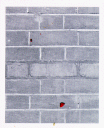
The brick exterior walls are generally in good condition; however, they exhibit two fundamental problems. The first is differential settlement of the walls resulting in vertical and diagonal settlement cracks in the brickwork. Although the settlement has been relatively minor, the damage to the walls has been compounded and exacerbated by repointing with hard, Portland cement mortar. This recently installed mortar is considerably harder, more rigid, and less plastic than the original lime mortar so that as settlement continues, additional damage is done to the original masonry. Also, the gray Portland cement mortar does not match the white color of the original mortar, and the tooling of the repointed areas does not match the original. The Portland cement mortar has been applied with considerably less care than the old mortar, and in many cases has been smeared over the face of the brick.
A related problem is the weathering away of both the brick arrises and pointing mortar leaving open joints between the bricks. The joints either remain open or havebeen unsatisfactorily repointed with Portland cement mortar.
The second major problem with the masonry walls is rising damp. Moisture in the ground beneath the building is drawn up through the masonry by capillary action. When this moisture, which contains salts dissolved from the soil and from the masonry through which it has passed, evaporates from the surface of the wall, some of the salts crystallize on the surface forming a white, powdery substance called efflorescence. The efflorescence that is seen on the surface usually causes little harm to the masonry, although it can draw and hold moisture on the surface of the wall. However, some of the salts crystallize behind the surface, exerting pressure within the masonry units. In time, the surface of the wall will become friable, and fragments of brick and mortar will spell away.
The surfaces of the brick walls are soiled from the deposition of airborne pollutants. These contaminants, especially those containing sulfur compounds, can unite with moisture to form acids that attack the brick and mortar surfaces. Additional defacing of the masonry has been caused by the chalking of the trim paint, which has run down the wall surfaces staining the brickwork.
The following is a listing of the masonry problems on each elevation:
West Elevation
- Especially poor Portland cement pointing under second first floor window from the south.
- Remnants of whitewash around basement windows.
- The brickwork has been stained to provide protection as well as to give a uniform appearance at some time in the past. The stain has weathered unevenly, giving the wall a mottled appearance.
- There is a build up of biological agents caused by dampness created by water running over the brickwork along the colonnade.
North Elevation
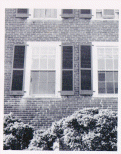
- Extensive areas of improperly pointed Portland cement mortar joints and accompanying open joints in wall.
- Settlement crack between basement and first floor window at the east end of building.
- Water from the roof is splashing back onthe brickwall after hitting the ground.
East Elevation
- Especially poor Portland cement pointing above and below first floor windows.
- The basement wall has been replaced with new brick, and there are no windows. The pointing is all Portland cement mortar, improperly applied.
- Two recently installed steel plates at second floor that anchor steel tension rods.
South Elevation
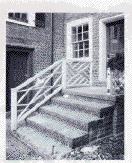
- Major vertical seam crack between original building and rear addition. The crack, which is approximately 2-1/2 inches wide at the top, has been filled with tinted mortar. It has apparently stabilized and is no longer continuing to open up.
- Settlement cracks east of doorway and between the basement and first floor windows of the rear addition.
- Extensive areas of improperly pointed Portland cement mortar joints and accompanying open joints in many areas of the wall. An especially bad area is located between the basement and first floor windows of the rear addition and the bottom of the garden wall adjacent to the building.
- Substantial bulge in the brickwork at the east end of the building between the basement and first floor windows.
- Bulge in brickwork near doorway; water collects on ledge.
Telephone Cables and Electrical Conduits
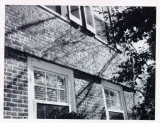
- Exposed telephone wires and electrical conduits are draped along the walls. They not only intrude visually, but also damage the masonry by collecting moisture.
- Rusting alarm box to east of doorway in south elevation.
WINDOWS
The historic wood windows are generally sound, although there is some localized wood decay and flaking paint. Much of the existing glazing compound is deteriorated, and there is excessive paint build-up on all windows. Most of the windows are in need of rehanging for proper operation and to reduce excessive air penetration.
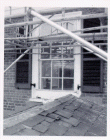
- Many of the windows have exterior shutters, which have deteriorated. Shutters are missing from the center window of the second floor of the east elevation.
- Portable air conditioners have been installed in the second floor windows of the north elevation.
- Second floor window of north elevation partially blocked by student room roof that has been raised from its original configuration.
- Crude hardware cloth screens cover the basement windows of the west elevation.
- Some window sills, particularly in the south elevation, are deteriorated and need consolidation.
DOORS
- The threshold of the main doorway (west elevation) is damaged, as are the panelmoldings on the main door.
- The four-light, two-panel door of the south elevation is not original. The brick and concrete steps and landing are badly deteriorated, as is the wood railing.
- There is a deteriorated storm door on the second floor doorway of the west elevation.
- There is a deteriorated wood screen door on the first floor level doorway of the east elevation. The doorway is flanked by two historically inappropriate carriage light fixtures.
INTERIORS
BASEMENT
Room B01 Stair Hall
- Original floor has been replaced with concrete.
- Heating pipes suspended from ceiling limit headroom.
- One panel of exterior door is cracked.
- Quarter round moldings have been applied to intersections of treads and stringers.
Room B02 Northwest Room
- Original floor has been replaced with concrete.
- Rising damp damage has occurred along north wall at east corner.
- Heating pipes suspended from ceiling limit headroom.
- Surface-mounted electrical wiring limits use of room.
- Door entablature is cracked.
Room B02A Pipe Room
- Original floor has been replaced with concrete.
- Heating mains for all buildings on east side of lawn are located along the west wall.
- Surface-mounted rigid electrical conduits are located on ceiling.
- Ceiling plaster is cracked and broken in areas.
Room B03 Laundry Room

- Original floor has been replaced by concrete.
- Heating and plumbing pipes suspended from ceiling limit headroom.
- Plumbing pipes along west wall limit use of room.
- Door entablature is cracked.
Room B04 Bedroom
- Moisture damage has occurred in southwest corner.
- Panel of door to Room B05 is cracked.
- Heating pipes suspended from ceiling limit headroom.
Room B05 Hall
- Original floor has been replaced with concrete.
- Rising damp damage has occurred in west wall.
Room B06 Bathroom
- Surface-mounted electrical wiring has been placed on door trim.
- Heating pipes suspended from ceiling limit headroom.
Room B07 Bedroom
- Original floor has been replaced with concrete.
- Heating pipes suspended from ceiling limit headroom.
- Rising damp damage has occurred along west and east walls.
FIRST FLOOR
Room 101 Entrance Hall
- Entrance door contains multiple pieces of hardware, many of which are no longer in use.
- South door entablature has been damaged and poorly repaired.
- One light of transom is cracked.
Room 102 Study
- Wood cornice has cracks at joints.
- Wood flooring has been applied over original floor.
- Fireplace firebox has been rebuilt and partially filled in.
- Built-bookshelves. Original chair rail removed.
Room 103 Stair Hall
- Plaster wall under south window is cracked.
- Quarter round moldings have been applied to intersections of treads and stringers.
Room 104 Rear Hall
- Surface-mounted electrical wiring has been placed on baseboard of south wall.
Room 105 Living Room
- Wood cornice has cracks at joints.
- Quarter round moldings have been applied to intersections of flooring and baseboards.
- Heavy build-up of paint is apparent on window architraves.
- Wood panels under west windows are cracked.
- Holes have been cut in wood cornices for exposed heating pipes.
- 6. Threshold of door to Room 104 is worn.
- Brick fireplace hearth has been painted.
Room 106 Pantry
- Quarter round moldings have been applied to intersections of flooring and baseboards.
Room 107 Lavatory
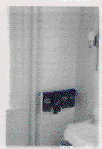
- Severe moisture damage and cracking has occurred in south wall.
- Window architrave is cracked.
Room 108 Kitchen
- Moisture damage has occurred in ceiling.
- Wood panel under east window is cracked.
- Quarter round moldings have been applied to intersections of flooring and baseboards.
Room 109 Dining Room
- Quarter round moldings have been applied to intersections of flooring and baseboards.
SECOND FLOOR
Room 201 Stair Hall
Moisture and settlement damage has occurred in walls at southeast corner.
- Surface-mounted electrical wiring has been attached to baseboard of stairway.
- Architrave on doorway to Room 206 is missing.
Room 202 Bedroom
- North wall has settlement cracks.
Room 203 Bedroom
- North wall has settlement cracks.
Room 204 Hall
- Quarter round moldings have been applied to intersections of flooring and baseboards.
Room 205 Bedroom
- Wood cornices have cracked at joints.
- See Appendix for fresco problems.
Room 206 Rear Hall
- Quarter round moldings have been applied to intersections of flooring and baseboards.
Room 207 Bathroom
- Moisture damage has occurred in east wall.
- Window entablature has cracks.
Room 208 Bathroom
- Settlement cracks have occurred in south and west walls.
- Window entablatures, south and east walls, have cracks.
- Door entablature has cracks.
Room 210 Bedroom
- Settlement cracks have appeared in south wall, above door to Room 206.
- Quarter round moldings have been applied to intersections of flooring and baseboards.
UTILITY SYSTEMS
ELECTRICAL SYSTEM
The electrical system was installed in the early twentieth century, and the last significant upgrading occurred in 1954. The existing system does not appear to be adequate. All existing lighting fixtures are inappropriate for a building that is so historically and architecturally significant.
HVAC SYSTEM
As is the case in most of the pavilions, the heating system consists of a circulating hot water system supplied with superheated hot water piped from a central heating plant. Exchange units located beneath the student rooms between the pavilions convert the superheated water to medium temperature hot water, which is then circulated through the building. Rooms are heated by cast-iron radiators. The entire system was installed early in this century. Generally, the pipes have been installed in a way that detracts from the historic appearance of the buildings. They are especially obtrusive in the basement where the supply mains run along the ceiling and in front of the windows. In some areas, hot water pipes have dried out adjacent masonry walls, resulting in deterioration of the masonry, the plaster wall and ceiling finishes, and the wood trim. In general, all of the pavilions are vastly overheated in winter.
PLUMBING SYSTEM
The plumbing system was last upgraded as part of the renovations carried out in 1954. The system appears to be near the end of its useful life expectancy.
FIRE DETECTION/SUPPRESSION SYSTEMS
There are no fire detection or suppression systems in the building.
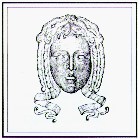 Table of Contents
Table of Contents
Last Modified: Wednesday, 02-Jul-1997 13:03:31 EDT
 Pavilion VI, like most of the other original Jefferson structures at the university, is generally in good condition, although it has received uneven levels of maintenance over the past seventeen decades. This is the case largely because of the soundly designed original construction details, the use of high quality materials, and the care that went into the original construction of the building.
Pavilion VI, like most of the other original Jefferson structures at the university, is generally in good condition, although it has received uneven levels of maintenance over the past seventeen decades. This is the case largely because of the soundly designed original construction details, the use of high quality materials, and the care that went into the original construction of the building.  Pavilion VI has survived with much of its original building fabric intact, despite having undergone major renovations in the period 1860-75, in 1928-29, and in 1954. Although some original building elements were either removed or covered over at these times, most of the work that was undertaken involved either the building or remodeling of an addition to the east of the original building.
Pavilion VI has survived with much of its original building fabric intact, despite having undergone major renovations in the period 1860-75, in 1928-29, and in 1954. Although some original building elements were either removed or covered over at these times, most of the work that was undertaken involved either the building or remodeling of an addition to the east of the original building. 

 The existing standing-seam terneplate roofing was applied directly over the original tinplate roof installed at Thomas Jefferson's direction on the main block of the pavilion. From the evidence that still exists, the present terneplate was the only roof ever installed over the original tinplate. Although the metals are similar, the standing seam roof does not have the same appearance as the original Jefferson roof. The strong vertical lines created by the standing seams are very different from the even texture of the original tinplate shingles. Jefferson's tinplate shingles measured approximately 6-3/4 by 10 inches and were fastened together along the 10-inch vertical dimension using a single-lock seam without solder or lead paste. Two shingles were cut from a single 10 by 13-1/2 inch tinplate pan, which was the standard sheet size of tinplate available at the time Pavilion VI was constructed. The horizontal courses were lapped approximately two inches; no lock seams were used on the overlap. This particular use of tinplate pans was unique to Jefferson. The technology used to install the shingles is significant because it required only basic carpentry skills and not sophisticated tinsmithing techniques to work and solder sheet metal.
The existing standing-seam terneplate roofing was applied directly over the original tinplate roof installed at Thomas Jefferson's direction on the main block of the pavilion. From the evidence that still exists, the present terneplate was the only roof ever installed over the original tinplate. Although the metals are similar, the standing seam roof does not have the same appearance as the original Jefferson roof. The strong vertical lines created by the standing seams are very different from the even texture of the original tinplate shingles. Jefferson's tinplate shingles measured approximately 6-3/4 by 10 inches and were fastened together along the 10-inch vertical dimension using a single-lock seam without solder or lead paste. Two shingles were cut from a single 10 by 13-1/2 inch tinplate pan, which was the standard sheet size of tinplate available at the time Pavilion VI was constructed. The horizontal courses were lapped approximately two inches; no lock seams were used on the overlap. This particular use of tinplate pans was unique to Jefferson. The technology used to install the shingles is significant because it required only basic carpentry skills and not sophisticated tinsmithing techniques to work and solder sheet metal.

 The entablature is generally in good condition. There is a heavy paint build-up on the wood; the paint coatings are alligatored and failing in other ways because of the excessive thickness of the paint. There is localized deterioration of the wood moldings caused by roof and gutter leaks. The horizontal moldings of the north and south elevations have been covered with sheet-metal flashings at some time within the past half-century. These flashings are deteriorated; the seams in the metal have failed, and the flashings have separated from the wood moldings.
The entablature is generally in good condition. There is a heavy paint build-up on the wood; the paint coatings are alligatored and failing in other ways because of the excessive thickness of the paint. There is localized deterioration of the wood moldings caused by roof and gutter leaks. The horizontal moldings of the north and south elevations have been covered with sheet-metal flashings at some time within the past half-century. These flashings are deteriorated; the seams in the metal have failed, and the flashings have separated from the wood moldings.






 Table of Contents
Table of Contents